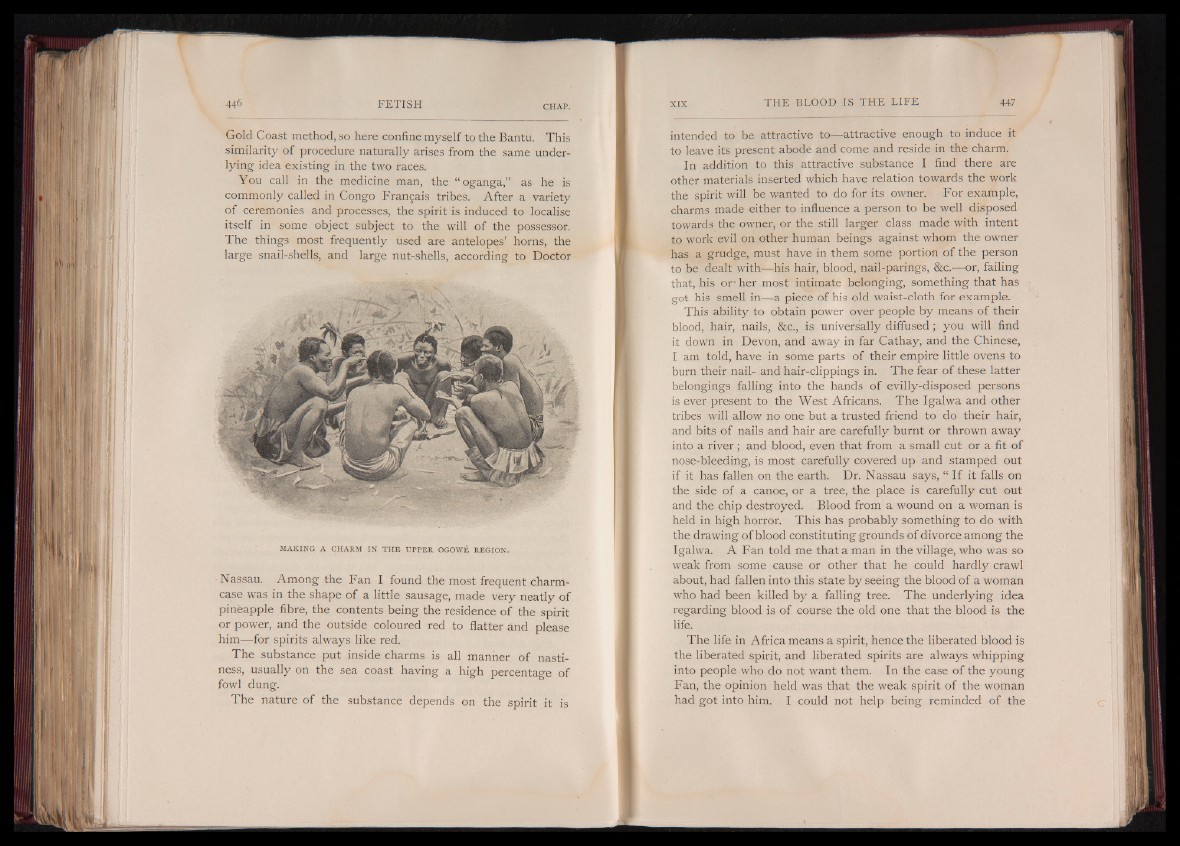
Gold Coast method, so here confine myself to the Bantu. This
similarity of procedure naturally arises from the same underlying
idea existing in the two races.
You call in the medicine man, the “ oganga,” as he is
commonly called in Congo Français tribes. After a variety
of ceremonies and processes, the spirit is induced to localise
itself in some object subject to the will of the possessor.
The things most frequently used are antelopes’ horns, the
large snail-shells, and large nut-shells, according to Doctor
MAKING A CHARM IN THE UPPER OGOWE REGION.
Nassau. Among the Fan I found the most frequent charm-
case was in the shape of a little sausage, made very neatly of
pineapple fibre, the contents being the residence of the spirit
or power, and the outside coloured red to flatter and please
him— for spirits always like red.
The substance put inside charms is all manner of nastiness,
usually on the sea coast having a high percentage of
fowl dung.
The nature of the substance depends on the spirit it is
intended to be attractive to— attractive enough to induce it
to leave its present abode and come and reside in the charm.
In addition to this attractive substance I find there are
other materials inserted which have relation towards the work
the spirit will be wanted to do for its owner. For example,
charms made either to influence a person to be well disposed
towards the owner, or the still larger class made with intent
to work evil on other human beings against whom the owner
has a grudge, must have in them some portion of the person
to be dealt with— his hair, blood, nail-parings, &c.— or, failing
that, his or- her most intimate belonging, something that has
got his smell in— a piece of his old waist-cloth for example.
This ability to obtain power over people by means of their
blood, hair, nails, &c., is universally diffused; you will find
it down in Devon, and away in far Cathay, and the Chinese,
I am told, have in some parts of their empire little ovens to
burn their nail- and hair-clippings in. The fear of these latter
belongings falling into the hands of evilly-disposed persons
is ever present to the West Africans. The Igalwa and other
tribes will allow no one but a trusted friend to do their hair,
and bits of nails and hair are carefully burnt or thrown away
into a river; and blood, even that from a small cut or a fit of
nose-bleeding, is most carefully covered up and stamped out
if it has fallen on the earth. Dr. Nassau says, “ I f it falls on
the side of a canoe, or a tree, the place is carefully cut out
and the chip destroyed. Blood from a wound on a woman is
held in high horror. This has probably something to do with
the drawing of blood constituting grounds of divorce among the
Igalwa. A Fan told me that a man in the village, who was so
weak from some cause or other that he could hardly crawl
about, had fallen into this state by seeing the blood of a woman
who had been killed by a falling tree. The underlying idea
regarding blood is of course the old one that the blood is the
life.
The life in Africa means a spirit, hence the liberated blood is
the liberated spirit, and liberated spirits are always whipping
into people who do not want them. In the case of the young
Fan, the opinion held was that the weak spirit of the woman
had got into him. I could not help being reminded of the